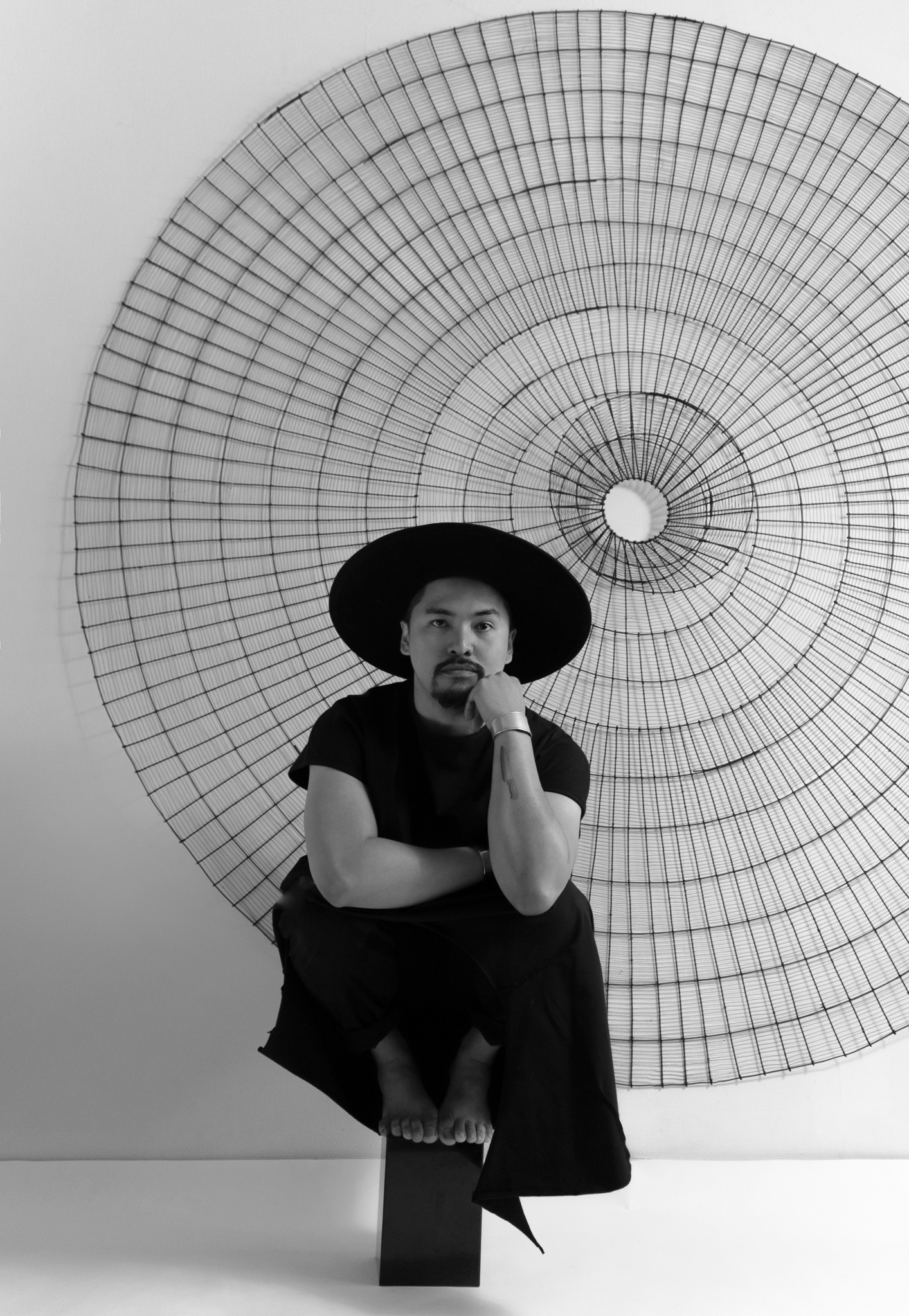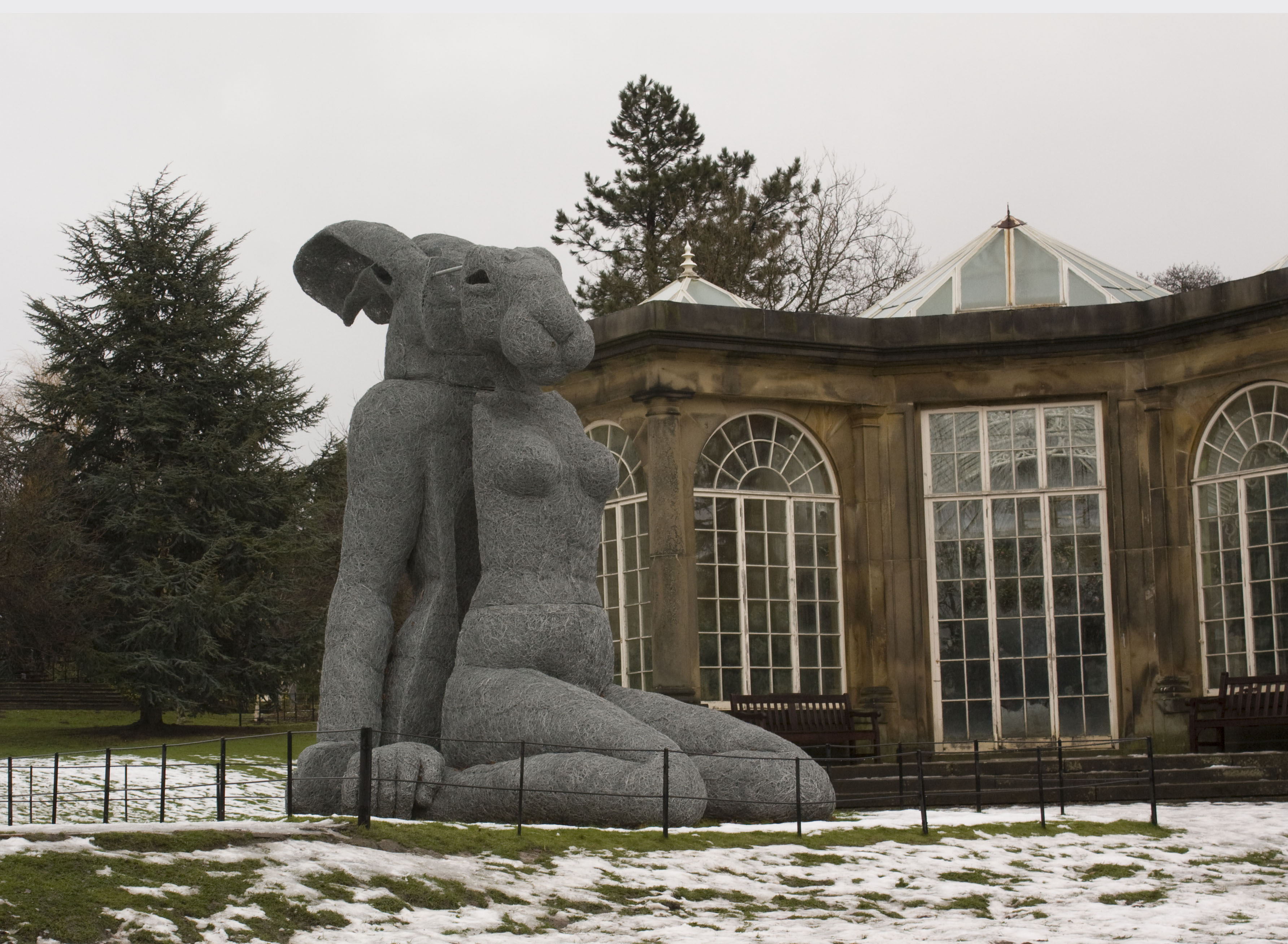Wire sculpture on:
[Wikipedia]
[Google]
[Amazon]
Wire sculpture is the creation of
 In 1962, Asawa began experimenting with tied wire sculptures of images rooted in nature, geometry, and abstraction.
In 1962, Asawa began experimenting with tied wire sculptures of images rooted in nature, geometry, and abstraction.
 *
*
sculpture
Sculpture is the branch of the visual arts that operates in three dimensions. Sculpture is the three-dimensional art work which is physically presented in the dimensions of height, width and depth. It is one of the plastic arts. Durable ...
or jewelry
Jewellery ( UK) or jewelry ( U.S.) consists of decorative items worn for personal adornment, such as brooches, rings, necklaces, earrings, pendants, bracelets, and cufflinks. Jewellery may be attached to the body or the clothes. From a w ...
(sometimes called wire wrap jewelry) out of wire
Overhead power cabling. The conductor consists of seven strands of steel (centre, high tensile strength), surrounded by four outer layers of aluminium (high conductivity). Sample diameter 40 mm
A wire is a flexible strand of metal.
Wire is co ...
. The use of metal wire in jewelry dates back to the 2nd Dynasty in Egypt and to the Bronze and Iron Ages in Europe. In the 20th century, the works of Alexander Calder
Alexander Calder (; July 22, 1898 – November 11, 1976) was an American sculptor known both for his innovative mobiles (kinetic sculptures powered by motors or air currents) that embrace chance in their aesthetic, his static "stabiles", and hi ...
, Ruth Asawa, and other modern practitioners developed the medium of wire sculpture as an art form.
Alexander Calder
Alexander Calder
Alexander Calder (; July 22, 1898 – November 11, 1976) was an American sculptor known both for his innovative mobiles (kinetic sculptures powered by motors or air currents) that embrace chance in their aesthetic, his static "stabiles", and hi ...
(July 22,1898–November 11,1976), an American sculptor, greatly developed the use of wire as a medium for sculpture with his kinetic and movement-based ''Cirque Calder
''Cirque Calder'' is an artistic rendering of a circus created by the American artist Alexander Calder. It involves wire models rigged to perform the various functions of the circus performers they represent, from contortionists to sword eaters to ...
'', as well as pieces such as ''Two Acrobats'', ''Romulus and Remus'', and ''Hercules and Lion''.
In 1926, after a stint spent making toys at the request of a Serbian toy merchant in Paris, Calder began creating his ''Cirque Calder'', a miniature, movable circus that uses movable wire models of various circus performers, like sword eaters and lion tamers. After this, Calder created complete pieces only using wire and in 1927 had a show of wire sculptures at the Weyhe Gallery
Weyhe Gallery, established in 1919 in New York City, is an art gallery specializing in prints. It is now in Mount Desert, Maine.
History
Erhard Weyhe (1883–1972) established the Weyhe Gallery in 1919. He also operated a bookstore, the Weyhe b ...
in New York City. In 1930, he had a solo show of wire sculptures in Paris, at Galerie Billiet.
Calder’s wire sculptures of this period tended to be portraits, caricatures, and stylized representations of people and animals. While originally believing the medium of wire sculpture to be merely clever and amusing, as his work developed, he began to state that wire sculpture had an important place in the history of art and remarked on the great possibilities within the medium.“These new studies in wire, however, did not remain the simple, modest little things I had done in New York. They are still simple, more simple than before, and therein lie the great possibilities which I have only recently come to feel for the wire medium...
There is one thing, in particular, which connects them with history. One of the futuristic painters' canons, as propounded by Modigliani, was that objects should not be lost to view but should be shown through the others by making the latter transparent. The wire sculpture accomplishes this in a most decided manner!"
Ruth Asawa
Ruth Asawa came to prominence when her wire sculptures appeared at both theWhitney Museum of American Art
The Whitney Museum of American Art, known informally as "The Whitney", is an art museum in the Meatpacking District and West Village neighborhoods of Manhattan in New York City. It was founded in 1930 by Gertrude Vanderbilt Whitney (1875–194 ...
and the 1955 São Paulo Art Biennial. Asawa learned to use commonplace materials from Josef Albers, her teacher at Black Mountain College, and began experimenting with wire using a variety of techniques.
In the 1950s, Asawa experimented with crocheted wire sculptures of abstract forms that appear as three dimensional line drawings. She learned the basic technique while in Toluca, Mexico, where villagers used a similar technique to make baskets from galvanized wire.
“I was interested in it because of the economy of a line, making something in space, enclosing it without blocking it out. It’s still transparent. I realized that if I was going to make these forms, which interlock and interweave, it can only be done with a line because a line can go anywhere.”
 In 1962, Asawa began experimenting with tied wire sculptures of images rooted in nature, geometry, and abstraction.
In 1962, Asawa began experimenting with tied wire sculptures of images rooted in nature, geometry, and abstraction.
Contemporary practitioners
Contemporary wire artists include: * Brian Boyer uses wire that would otherwise end up in a landfill to create wire trees. Known for his self-taught style and use of recycled copper/aluminum wire. His trees combine mathematical formulas, algorithms, and equations along with geometric shapes along with flowers and many other abstract patterns in the roots and branches. As of 2018 Brian has had an active profile with the "Canadian Council for the Arts" and continues to make his one of a kind wire trees under the brand name "Forrest Wire" * Gavin Worth has used wire sculpture to combine realistic images with 3-d abstract forms. Worth approached Calder's idea of mobility in sculpture by making the viewer the mobile element. By placing varying images on different planes of the sculpture, the image changes as the viewer see it from different angles. * Kue King has built a reputation combining wire and feather. He sculpts wire using a woven additive technique. Instead of creating a form with wireframing, he builds with it like clay. * Elizabeth Berrien began working with wire in the 1960s and is hailed as the "Godmother of Wire" by the wave of emerging wire sculptors she inspired. * Racso Jugarap works speak of organic volume and fluidity. Other than wire sculpture and installations, the artist also experiments with wearable wire arts. *
*Robin Wight
Robin Wight CVO CBE was president of The Engine Group ('Engine') from 2008-2019. He was a co-founder of the advertising agency WCRS, which he set up in 1979 and which merged to become Engine Creative in 2020. He also established the Ideas Foun ...
creates wire sculptures of fairies. He works with stainless steel wire. One of his more notable works is Dancing with Dandelions
Jewelry
Because the needed tools are simple, wrapped wire jewelry can be learned and performed in home studios by hobby artists. Some of the tools used includepliers
Pliers are a hand tool used to hold objects firmly, possibly developed from tongs used to handle hot metal in Bronze Age Europe. They are also useful for bending and physically compressing a wide range of materials. Generally, pliers consist ...
, pin vises, file, wire cutter
Diagonal pliers (also known as wire cutters, diagonal cutting pliers, diagonal cutters, side cutters, dikes or Nippy cutters) are pliers intended for the cutting of wire (they are generally not used to grab or turn anything). The plane define ...
s, and mandrel
A mandrel, mandril, or arbor is a gently tapered cylinder against which material can be forged or shaped (e.g., a ring mandrel - also called a triblet - used by jewelers to increase the diameter of a wedding ring), or a flanged or tapered or ...
s.
The wire used may be of a variety of decorative metals in different cross-sections. Wire sculpture jewelry may have bead
A bead is a small, decorative object that is formed in a variety of shapes and sizes of a material such as stone, bone, shell, glass, plastic, wood, or pearl and with a small hole for threading or stringing. Beads range in size from under ...
s or gemstone
A gemstone (also called a fine gem, jewel, precious stone, or semiprecious stone) is a piece of mineral crystal which, in cut and polished form, is used to make jewelry or other adornments. However, certain rocks (such as lapis lazuli, opal, ...
s integrated into the design.
Metals used
For most people who start out working with wire, it is not cost-effective to jump straight to precious metals such as silver or gold. Therefore, less expensive craft wires made from softer materials such as brass, copper, aluminum, or gold fill can be used. The artist typically first gains experience exploring form while learning the feel of the wire. There are many ways wire can be handled and wrapped. Progression can be made to the more expensive metals such as 925 sterling silver and 14k gold-filled wire. 14k gold-filled wire is a tube of 14k gold that has a length of jewelers brass running through the middle. It is not like gold plated wire as there is approx 100 times more gold in gold filled than there is on the plated wire. With gold-filled wire that is designated 14/20 it means that a minimum 20% of the entire wire is 14k gold. As with solid gold the gold-filled wire can come in at least yellow and rose colors enabling the range of jewelry that can be made to be expansive.See also
*Art jewelry
Art jewelry is one of the names given to jewelry created by studio craftspeople. As the name suggests, art jewelry emphasizes creative expression and design, and is characterized by the use of a variety of materials, often commonplace or of low e ...
* Bronze and brass ornamental work
* Estate jewelry
Antique Jewelry or Estate Jewelry (or Estate Jewellery), in a formal sense, is jewelry and often timepiece
A clock or a timepiece is a device used to measure and indicate time. The clock is one of the oldest human inventions, meeting t ...
* Jewellery
Jewellery ( UK) or jewelry ( U.S.) consists of decorative items worn for personal adornment, such as brooches, rings, necklaces, earrings, pendants, bracelets, and cufflinks. Jewellery may be attached to the body or the clothes. From a w ...
References
External links
* {{Jewellery Jewellery making Sculpture techniques Wire